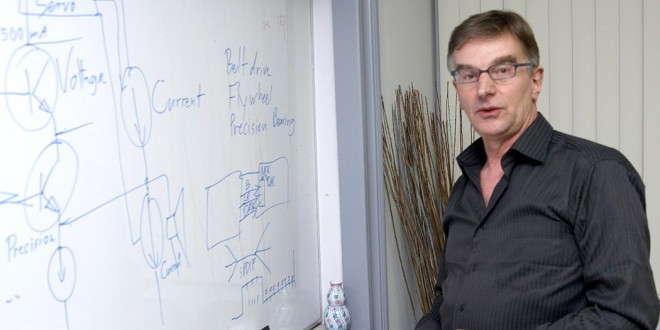唱放 PHONO MC-CI
Hi Leo,
Now some more about CI, this time for PHONO, Moving Coil (MC) at a CI input. This explains the name of the B.M.C. Audio Phono Amplifier: PHONO MCCI
這次解釋CI在唱放PHONO MCCI上的應用。
There have been some phono amplfiers in the past with something like a CI input, most times a simple grounded-base-circuit with several transistors in a Faulkner array. In the 1980s I myself had a Threshold SL10, designed by Nelson Pass.
過去有些唱放使用了像CI的輸入,大部份使用多個以Faulkner排列的電晶體,簡單以接地為基礎的線路。在1980年代我自己有Nelson Pass設計的Threshold SL10。
There is a difficulty with this circuit. Please look again at T2 (Picture T2):
With the usual unbalanced RCA connectors the Moving Coil Pickup is connected on one side to ground, and ground is connected to B (Base) of the transistor, whereas the hot signal is connected to E (Emitter). The problem is: Due to the nature of a transistor there is a voltage of about 0.6V between E and B! 0.6V at a very tiny coil may easily burn this coil! The usual solution (as in my old SL10) is to put a capacitor between the MC pickup and E. Working? Yes. Perfect? Far from it! The signal of an MC is a very tiny signal and should be treated with great care. A capacitor not only blocks DC, but some sound quality as well.
這樣的線路是有困難的,請看T2圖:在一般非平衡RCA下,MC唱頭的一邊是接到地,地是接到電晶體的B(Base),正級則是接到E(Emitter)。這樣的問題是,因為電晶體本身的特性,在E與B間存在0.6V的電壓,0.6會讓較小的線圈燒掉,一般解決的方法是在MC唱頭與E間放一個電容,不過這種方式雖然可解決問題,但對聲音不好,MC的訊號非常微小,應該受到很好的照顧,一個電容不僅阻擾了DC,對聲音的影響也一樣。
….I’ll better make a shortcut to the BMC MC-CI solution:
As a Moving Coil Pickup itself is a perfect balanced and earthfree source, and all our designs are balanced, keeping it balanced is the perfect solution. For some it may need some new wiring or balanced connectors, but that’s it.(Picture MC-CI)If the MC is connected with both ends to one and the other E of a balanced CI-input, all problems are gone. This is the perfect solution for Moving Coil Pickups!
我簡單的對BMC MC-CI解決方案說明,當MC唱頭本身是完美平衡與免於接地的來源,包括我們所有的設計是平衡的,那麼保持平衡就是最完美的解決方案。某些也許需要一些新的接線或平衡的端子,請看圖MC-CI
As the impedance (resistance) of an MC is quite low, there is a good chance to get high gain. Let us imagine the MC pickup plus cable plus input resistance of the CI input has a resistance of 5 Ohm. If we use 5 kOhm at the output of the CI stage, we get a gain of 1000. But if you have a High-Output MC pickup with 50 Ohm, gain will be just 100. This means there is some kind of an “automatic” correction of pickups with different output voltages…..Add a resistor-capacitor combination at the output of the CI stage and you can get the first half of the RIAA correction.
當MC的阻抗(電阻)非常低,有一個很好的機會可以得到高的增益。讓我們想像MC唱頭加上線、加上MC輸入的輸入電阻其總共電阻為5 Ohm。如果我們使用5 kOhm在CI輸出級,我們就有1000倍的增益。但如果您有高輸出的MC唱頭是50 Ohm,增益只有100。這意味著存在自動效正不同輸出電壓的唱頭。增加1個電組電容到CI的輸出級,您能得到第1個RIAA修正的1半。
The second gain stage needs making a copy, and the second half of the RIAA at the output ensures a complete correction. The final output stage is a small LEF buffer for driving cables and the following input. Thus there are only 2 copies made in the PHONO MCCI.
第2個增益需要1個COPY(訊號),以及在輸出的第2個1半的RIAA確保了完整的修正。最後的輸出級是一個小的LEF緩衝來驅動線材與輸入。因此總共只有2次的COPY在PHONO MCCI中。
CI has one more advantage for PHONO MC: As the current of the MC flows into the CI input, there is a natural damping of the electro-mechanical system. If you use a usual voltage input (Picture T1) there is nearly no current flowing into B – and the moving parts keep oscillating. That’s why usual phono inputs have resistors for finetuning the damping. But it is always a compromize: The lower the resistor, the better the damping – but: The energy is distroyed in the resistor – and it really sounds like lost energy. CI makes use of the energy, and thus it sounds like energy.
CI還有一個對PHONO MC的優點,當MC電流進入CI輸入級,有1個電磁系統的天然阻尼存在。如果你使用一般的電壓輸入 (如圖T1),將近沒有任何電流會進到B,移動的部分會持續擺動。這也是為什麼一般的唱放書入有電組來調整阻尼。不過這樣總是是妥協的作法,較低的電阻,越好的阻尼,但能量會在電阻中遭到破壞,聽起來會沒能量。CI則是使用能量、聽起來有能量。
A last hint for using B.M.C Audio PHONO MCCI: This Unit is working with almost all available Moving Coil pickups, even the ones designed for stepup-transformer use. The best dynamic performance is to be expected if a strong magnetic circuit is used and the impedance is low (recommended: under 10 Ohm).
最後一個使用B.M.C Phono MCCI的重點,其可對應使用大部份的MC唱頭,甚至是需要升壓器的唱頭。如果有夠強的磁力線路與低阻抗(建議低於10 Ohm),那麼會有最佳的動態表現
最少的訊號COPY
Dear Leo,
This time I like to write about reducing the process of “making copies“ to the minimum. And it is related of how to connect the B.M.C. units.
這次我要解釋B.M.C的設備是要減少COPY訊號的數量到最小,這同時也是對B.M.C.器材間如何相連的解釋。
Translation may be difficult. After reading your translations to Chinese, I can see that “copy“ is not translated. I could not find an online translation with the exact same meaning. What do you think: Is it better to use “generation“ instead of ‘copy“? Means: If you make a copy of the original signal, you get the second generation of the original signal.
翻譯或許很困難,我看到你並沒有翻COPY,或者是用”generation”這個詞比較好,如果你COPY原來的訊號,那麼你就會得到原來訊號的第2代。
PS 其實我沒翻COPY主要有兩個原因,第1個是因為大概所有人都懂COPY這個英文的意思,第2是保留COPY比較不會因為翻譯造成原文許多精神遺失
As I explained before: There are copies of the input signal needed, in case you need more current at the output as you can get at the input. As a Moving-Coil pickup or a DAC-Chip does not deliver enough current for driving speakers, there is at least one copy required. Means: In the best case you listen to the second generation.
如同我解釋過的,當你輸出需要比輸入更多的電流時,就存在COPY輸入訊號的需要。當MC唱頭或DAC晶片沒提供足夠的電流驅動喇叭,那麼就只少要COPY一次,也就是說你聽到的是第2代的訊號了。
Our units are intended for using the fewest possible copy processes. But they should be compatible in a setup with other units as well. Our DAC1PRE should be working with active speakers as well as with other power amplifiers, and our power amplifiers should work with other preamps as well. In case you use DAC1PRE and AMP S1 or M1 as a set, there is a shortcut, avoiding some copy stages, or generations.
B.M.C 要使用最少的COPY過程,但是他們要能與其他器材相容,如DAC1PRE要能與主動式喇叭或是後級搭配,B.M.C的後級也要能與其他品牌的前級搭配,如果您使用AC1PRE與AMP S1或M1搭配,就不會有任何的COPY或Generations產生。
